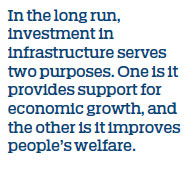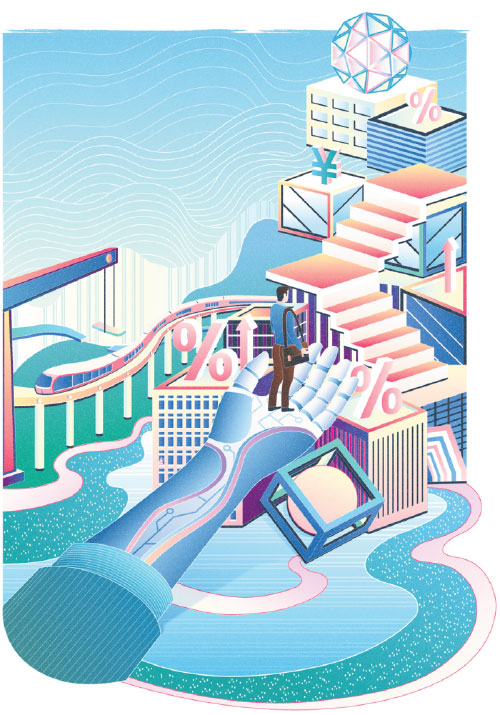Promoter of growth and welfare
Question is not whether we should have debt-financed investment but how much and for what purpose
Early this year, the central government approved a fiscal package of more than 3 trillion yuan ($436.82 billion) for local governments to increase their debt-financed spending. Most of the newly added spending has gone to infrastructure investment that either restarts stalled government projects or opens new ones. This has been questioned by many observers. After all, it has become a consensus that China should exit from the investment-driven model of growth and shift to an innovation-based model.
There is much merit in this consensus. Before 2010, China's growth heavily relied on investment. Capital formation once accounted for half of GDP. As a result, the Chinese economy was seriously imbalanced. But, the economy has been rebalancing since 2010. Capital formation as a share of GDP has dropped quickly, and consumption has consistently contributed more than 70 percent of growth in recent years. In a nutshell, China's economy is no longer one driven by investment.

However, this does not mean that China needs no more infrastructure investment; neither does it mean that China should never use fiscal investment to stimulate the economy.
In the long run, investment in infrastructure serves two purposes. One is it provides support for economic growth, and the other is it improves people's welfare. While several kinds of infrastructure investment, such as that used for the construction of industrial parks, only serve the first purpose, most of them serve both purposes. Take high-speed railways for example. They certainly improve efficiency by expediting business people's travel, yet their most significant function is to allow ordinary people to enjoy faster and more comfortable trips when they visit family members or go sightseeing. There are many other similar examples. Returning to these kinds of investment would mean better welfare for ordinary people, not higher rates of growth. For this reason, they should be treated more as a kind of consumption than as a kind of capital formation. And to allow Chinese people to enjoy the kind of public amenities that people in developed countries enjoy, China still needs a lot of such investment.
In the short run, infrastructure investment can also be used as a counter-cyclical tool to smooth out economic fluctuations. Business cycles are an inherent feature of any economy, be it well-planned or completely free-wheeling. This is because business investment is driven by expectations - when expectations are high, over-investment ensues, and when expectations are low, under-investment is the result. The purpose of macroeconomic management is to subdue such fluctuations. There are only two broad sets of policy tools, fiscal policy and monetary policy, to accomplish that goal. When the economy is over-performing, the government should adopt austerity policies - tightening government spending and money supply, and when the economy is under-performing, the opposite policies should be adopted. Infrastructure investment, as a kind of government spending, can serve to jump start the economy when business investment is sluggish.
This is more important in China than in other countries. When he was elected, US President Donald Trump vowed to start a giant infrastructure investment program in the United States. But there has not been any serious investment except for the wall that is being built on the border with Mexico. In China, it is much easier. For one thing, local governments, for good or bad, are eager to undertake infrastructure investment. The record of performance, though, has not been bad.
It is worth keeping in mind, however, that approving the positive roles of infrastructure investment doesn't mean we have to ignore the debts it has accumulated. But, completely avoiding debt-financed investment is not a good decision. It is reasonable to shift some of the debts to future generations because there is no reason why future generations should automatically possess the right to enjoy a better life than the current generations. In reality, the current generations should be awarded for their hard work over the last several decades. The issue is thus not about whether we should have debt-financed investment but about how much and for what purpose. Because infrastructure investment serves public purposes, it is the best to finance it by public debts, not commercial borrowings. On this count, of course, the government has much due diligence to do.
The author is professor and dean of the National School of Development of Peking University. The author contributed this article to China Watch, a think tank powered by China Daily. The views do not necessarily reflect those of China Daily.

(China Daily Global 05/21/2019 page13)


















